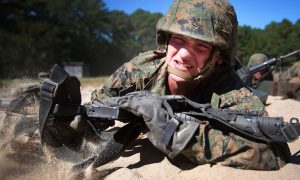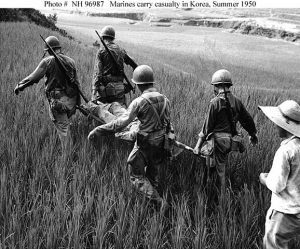"That two battalions of Marines be raised consisting of one colonel, two lieutenant colonels, two majors and officers as usual in other regiments, that they consist of an equal number of privates with other battalions; that particular care be taken that no person be appointed to office or enlisted into said battalions, but such as are good seamen, or so acquainted with maritime affairs as to be able to serve to advantage by sea." (Resolution of the Continental Congress, 10 November 1775.)
November 10 marks the birthday of the United States Marine Corps. On this day in 1775, the Continental Congress passed a resolution calling for the creation of two battalions of Marines to serve the new nation. Each year in Marine posts throughout the world, traditions such as the birthday ball and the cutting of birthday cake continue, bonding generations of warriors together as they celebrate their shared brotherhood.
These fighting men and women are an elite group, and well they know it! Throughout their history, they have been given the specialized and often dirty jobs deemed necessary to win wars. From clashes with Barbary Pirates to the special ops of today, they have gloried in their victories and stuck out the rough times in between. When times of war are upon us, the Marines can be counted on to play key roles in the fighting.
Learn more about the fascinating history of the Marine Corps in the library and on the Internet.
In the Library
The Black Sheep
Before they were the Black Sheep Squadron, the 214 was a group of recruits known as the Swashbucklers. Gamble, a retired naval officer, gives the complete history of the unit in World War II including the Pappy Boyington years that inspired the hit television series Baa Baa Black Sheep.
The Germans called the Marines teufelhunden or devil dogs for their invincible spirit in France. At Belleau Wood, Soissons and Mont Blanc, they fought alongside the regular army, ultimately uprooting their enemies from trenches, tunnels and caves.
The Greatest U.S. Marine Corps Stories Ever Told
Editor Iain Martin has accumulated these Marines' most amazing true tales of service and sacrifice, from the Halls of Montezuma to the shores of Tripoli to the conflicts where they serve today.
Making the Corps
What does it take to be a U.S. Marine? Ricks follows a platoon of recruits through eleven weeks of boot camp at Parris Island and examines what goes into the creation of a military elite.
Marine
Read about the Marines' fighting spirit and weaponry. Clancy goes inside a seaborne emergency response team used in both peace-keeping and warfare.
On Desperate Ground
"In the misting rain, they pressed against the metal skins of their boats and peeked over the gunwales for a glimpse of the shores they were about to attack. Some thirteen thousand men of the First Marine Division, the spearhead of the invasion, had clambered down from the ships on swinging nets of rope and then had crammed themselves into a motley flotilla of craft that now wallowed and bobbed in the channel. Several of the rusty old hulks, having been commandeered from Japanese trawlermen, smelled of sour urine and rotten fish heads. The Marines, many of them green from seasickness, saw the outlines of the charred foothills that rose above the port, and caught the scent of the brackish marshes and the slime of the mudflats. Corsairs, bent-winged like swallows, dove over the city, dropping thousand-pound bombs and sending five-inch rockets deep into hillside nests where the enemy was said to be dug in. Far out at sea, the naval guns rained fire upon the city, damaging tanks of butane that now flared and belched palls of smoke." (From the prologue)
Through the Wheat, opens a new window
A vivid and detailed study of the role of U.S. Marines in World War One.
With the Old Breed at Peleliu and Okinawa, opens a new window
A former member of the First Marine Division gives a front line description of two World War II Pacific campaigns. CRRL also own its sequel, China Marine., opens a new window
On the Web
First Offensive: The Marine Campaign for Guadalcanal
"In the early summer of 1942, intelligence reports of the construction of a Japanese airfield near Lunga Point on Guadalcanal in the Solomon Islands triggered a demand for offensive action in the South Pacific." Maps, photographs and text accompany this 50th Anniversary USMC commemorative site.
The National Museum of the Marine Corps
"The National Museum of the Marine Corps is a lasting tribute to U.S. Marines — past, present, and future. Situated on a 135-acre site adjacent to the Marine Corps base in Quantico, Virginia, the Museum’s soaring design evokes the image of the flag-raisers of Iwo Jima and beckons visitors to its 118,000-square-foot structure. World-class interactive exhibits using the most innovative technology will surround visitors with irreplaceable artifacts and immerse them in the sights and sounds of Marines in action."
The Navajo Code Talkers
In World War II, the Marine Corps recruited Navajos to their ranks to act as code talkers, enabling the United States to quickly and accurately relay messages that were indiscernible to enemy spies. This is part of their story.
Small Unit Action in Vietnam, Summer 1966
Originally printed in 1967, this official publication is a very readable and yet historically accurate war story which teaches lessons in sound military tactics.




